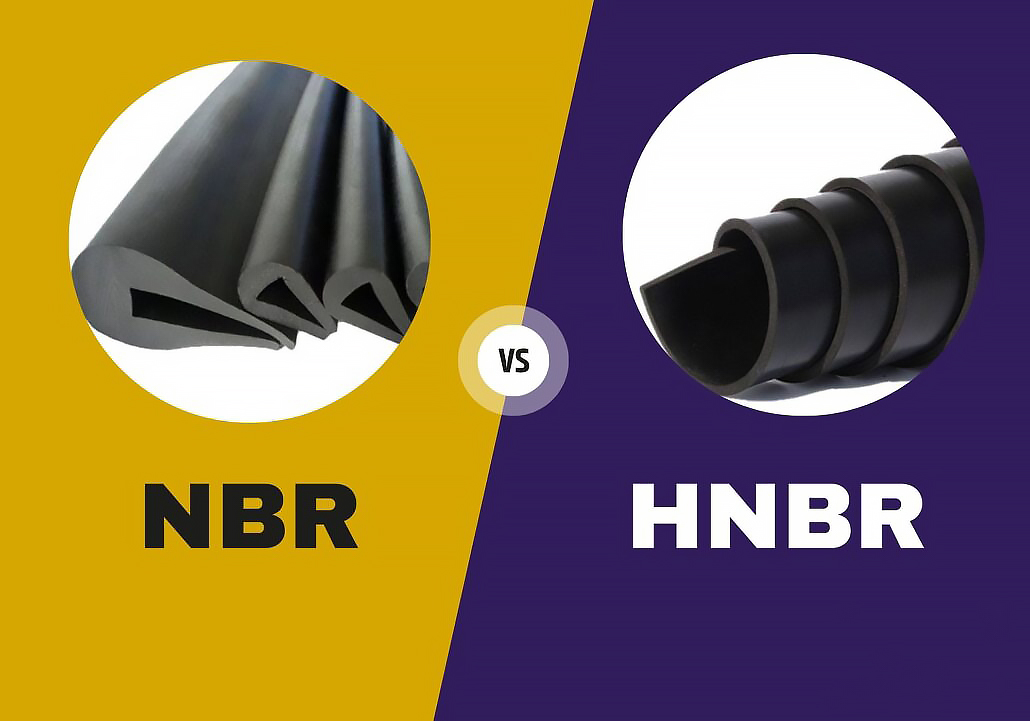Lead Paragraph
From car engines to kitchen gloves, two types of rubber—NBR and HNBR—work silently behind the scenes. Though they sound similar, their differences are as stark as an umbrella versus a bulletproof vest. Here’s how these “rubber siblings” shape everything from your morning coffee maker to deep-sea drilling rigs.
1. The Rubber Family Tree: Meet the Twins
NBR: The Everyday Hero
Think of NBR as your trusty umbrella. Made from butadiene (a flexible component from petroleum) and acrylonitrile (an oil-resistant powerhouse), it’s affordable and reliable—until extreme conditions strike.
-
Where You’ll Find It: Bike tire liners, disposable gloves, and cheap rain boots.
-
Weak Spot: Cracks under prolonged sun exposure or temperatures above 120°C (think melted chocolate).
HNBR: The Indestructible Upgrade
HNBR is NBR’s high-tech cousin. Scientists “reinforce” its molecular structure using hydrogen, turning fragile “knots” into unbreakable bonds.
-
Superpower: Survives 150°C heat and resists aging like sunscreen.
-
Cost: 3–5x pricier due to a platinum-catalyzed “alchemy” during production.
Key Analogy:
If NBR is a necklace with weak clasps, HNBR welds those clasps shut—making it tough enough for car engines and Arctic expeditions.
2. Extreme Tests: Heat, Cold, and Lifespan
Temperature Wars
-
NBR: Fails at 120°C (like a floppy umbrella in a storm).
-
HNBR: Thrives at 150°C (a heatproof shield for engine parts).
Real-World Example:
Summer car interiors hit 70°C—cheap rubber mats turn sticky, while HNBR stays firm.
Durability Face-Off
-
NBR: Cracks after 3–5 years outdoors.
-
HNBR: Lasts over a decade, even in UV-heavy environments.
DIY Experiment:
Tie both rubbers to a balcony railing. After a year, NBR will crack; HNBR remains stretchy.
3. Hidden in Plain Sight: Their Secret Roles
NBR’s Everyday Domains
-
Kitchen: Oil-resistant baking gloves.
-
Transportation: Motorcycle oil hoses, bike tire liners.
-
Healthcare: Cheap disposable gloves (but not for harsh chemicals).
HNBR’s High-Stakes Missions
-
Auto Industry: Turbocharger hoses, engine seals in luxury cars.
-
Extreme Environments: Deep-sea drilling gaskets, ski suit seams.
-
Future Tech: Shields for electric vehicle batteries.
Did You Know?
A luxury car’s engine likely has 5+ HNBR parts—yet most drivers never notice!
4. Why HNBR Costs a Fortune
The “Alchemy” Behind It
Making HNBR isn’t just mixing ingredients—it’s a high-pressure, platinum-catalyzed process. The catalyst alone eats 30% of the cost.
Eco Paradox
Producing HNBR emits double the CO₂ of NBR. But its longer lifespan means fewer replacements, making it greener over time—like a durable winter coat versus fast fashion.
5. Choosing Wisely: A Buyer’s Guide
When to Pick NBR
-
Short-term fixes (e.g., temporary seals).
-
Cold environments (fridge door gaskets).
-
Budget items (kids’ rain boots).
When to Splurge on HNBR
-
High-heat appliances (rice cooker seals).
-
Critical safety gear (lab equipment connectors).
-
Long-term investments (premium car parts).
Pro Tip:
Online listings boasting “150°C resistance” or “10-year warranty” likely use HNBR—cross-check prices to avoid scams!
6. The Future: Will One Rubber Rule Them All?
While HNBR dominates high-tech fields, NBR isn’t going extinct. Scientists are:
-
Boosting NBR’s lifespan with antioxidants.
-
Crafting eco-friendly HNBR from corn starch.
Wild Prediction:
Potato-based “bulletproof rubber” could someday protect Mars rovers—and your coffee maker.
Final Takeaway
Next time you see a rubber product, ask: “Is this the umbrella or the bulletproof vest?” Their silent rivalry keeps our world running—from grocery store gloves to space station seals.
Post time: May-28-2025

